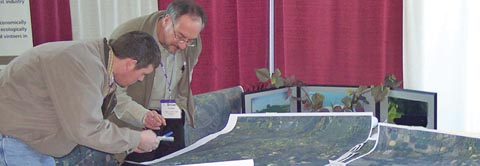
Using aerial imagery maps, Ryan Wells, left, viticulturist for Icon Estates, and Brian Carter, winemaker for Apex Cellars, identify the boundaries of Apex’s Outlook Vineyard. Tree fruit growers are also mapping their orchards with funding from the U.S. Department of Agriculture’s Risk Management Agency.
Photo courtesy of Washington Wine Industry Foundation
An on-line service that’s helping Oregon vineyardists and winemakers share information to help each other produce the highest quality grapes and wines may have application in Washington State.
The Oregon Vineyard Inventory Database is a new service designed to help growers and vintners work together to identify vineyard sites, plantings, and management practices that lead to growing the best wines at the lowest cost, said Alan Campbell, executive director of the project.
The goal of the membership-funded service, said Campbell, “is outcome based‹how to produce the best wine grapes out of your blocks.”
On-line forms are used by growers to record things like bud break and bloom dates, vine growth, pest and disease issues, and record management practices, including pesticide applications. The information, shared on-line with other member growers, helps vineyardists improve management decisions and facilitates industry communication throughout the season.
Gathering grower information across the state also helps researchers track viticultural and pest trends.
“We need better information, better communication, and better tools to increase wine quality, and we need to do it more efficiently,” he said during the Washington Association of Wine Grape Growers annual meeting held in Kennewick, Washington.
Campbell sees value in Oregon, Idaho, and Washington working together as a region, creating synergy to “grow the best wines in the world.”
Each state has its particular wine niche, he added. “We don’t really compete, because we grow different varietals.” For example, Oregon is a cool climate region, producing primarily Pinot Noir wine grapes, whereas much of Washington is a warm climate, and produces a range of varietals.
Location
The first step taken in the database project was to locate Oregon vineyards. Digital orthophoto quadrangles were used as maps, with growers and industry experts using markers to identify existing vineyards. The quadrangles are aerial images that are captured every six years and available from the U.S. Geological Service. Vineyards were then transferred from maps to a computer database.
“We found that in one county, we had 20 percent more acreage planted to vines that were not included in the National Agricultural Statistics Service report,” Campbell said, noting that statewide, the mapping process added 300 vineyards to the Oregon Wine Board’s list and added 10 percent more acres.
To keep the maps up to date, large sheets of aerial maps are hung on walls during industry meetings for growers to mark new plantings and note new contacts.
“This simple process has mapped 650 vineyards in Oregon,” he said, noting that the process was relatively inexpensive, simple to implement, and got the industry involved.
“Mapping is useful in tracking trends, identifying high quality vineyard land, and protecting high-value sites from development into view lots,” Campbell said.
In addition to location, the database contains information like slope, elevation, and aspect. “This knowledge helps growers understand their vineyard and learn what high potential land is within an appellation.”
Vineyard soil information is also part of the program.
The last phase of the on-line resource allows growers to create a digital record of their vineyard management practices.
Campbell said an important element of the program is that the members control who can view their on-line information.
Other program benefits he identified include helping industry make the transition to computer-based decision making, bringing attention to wine grape costs and outcomes, assisting growers in analyzing fruit quality, and improving discussion within the industry.
“I think we have something useful for the Northwest wine region,” he said, adding that the database could be expanded to include Washington and Idaho.
Through a grant received from the U.S. Department of Agriculture’s Risk Management Agency, the foundation awarded the Oregon vineyard database nearly $45,000 to help complete the last phase of the project and determine if the database would benefit the entire Northwest grape and wine industries.

Leave A Comment